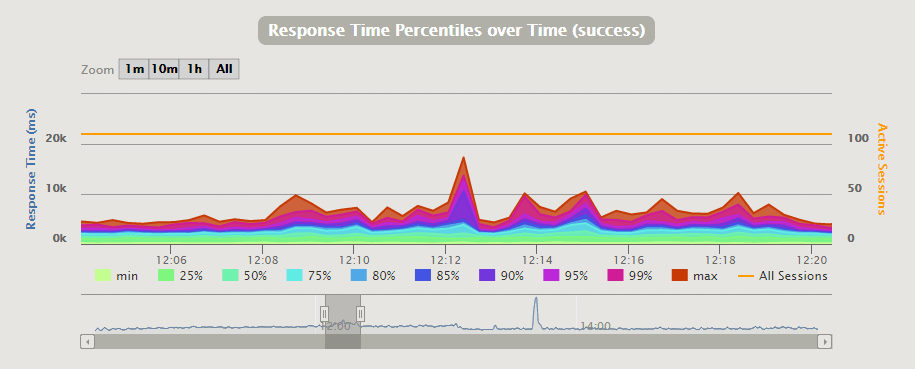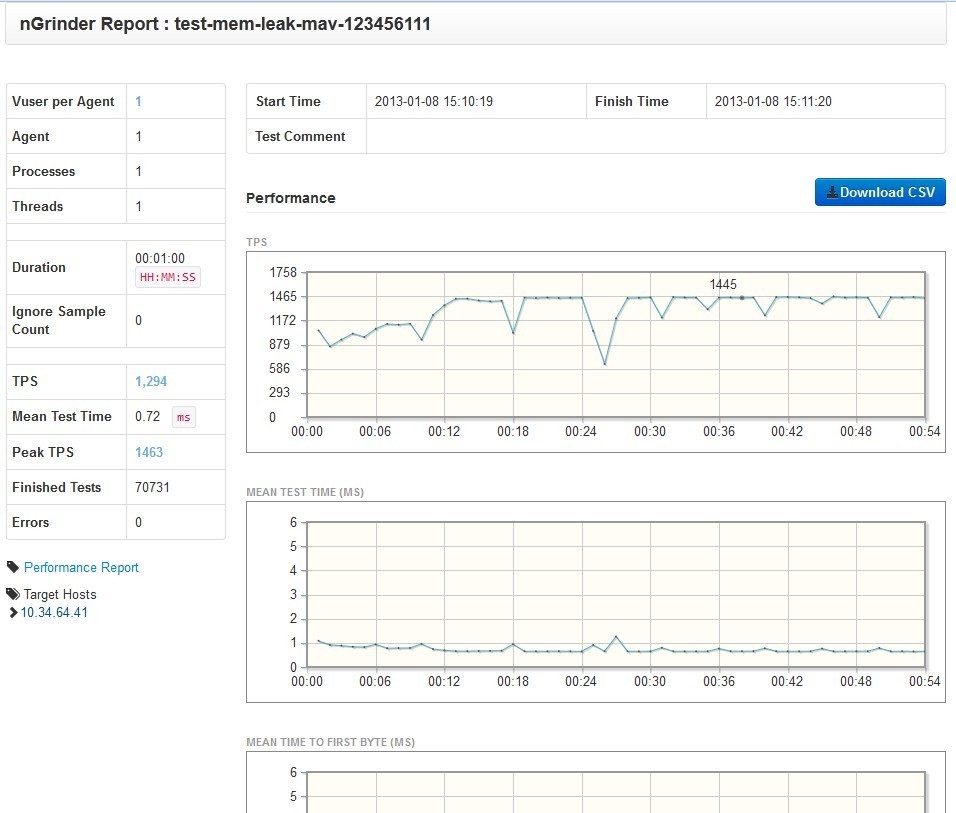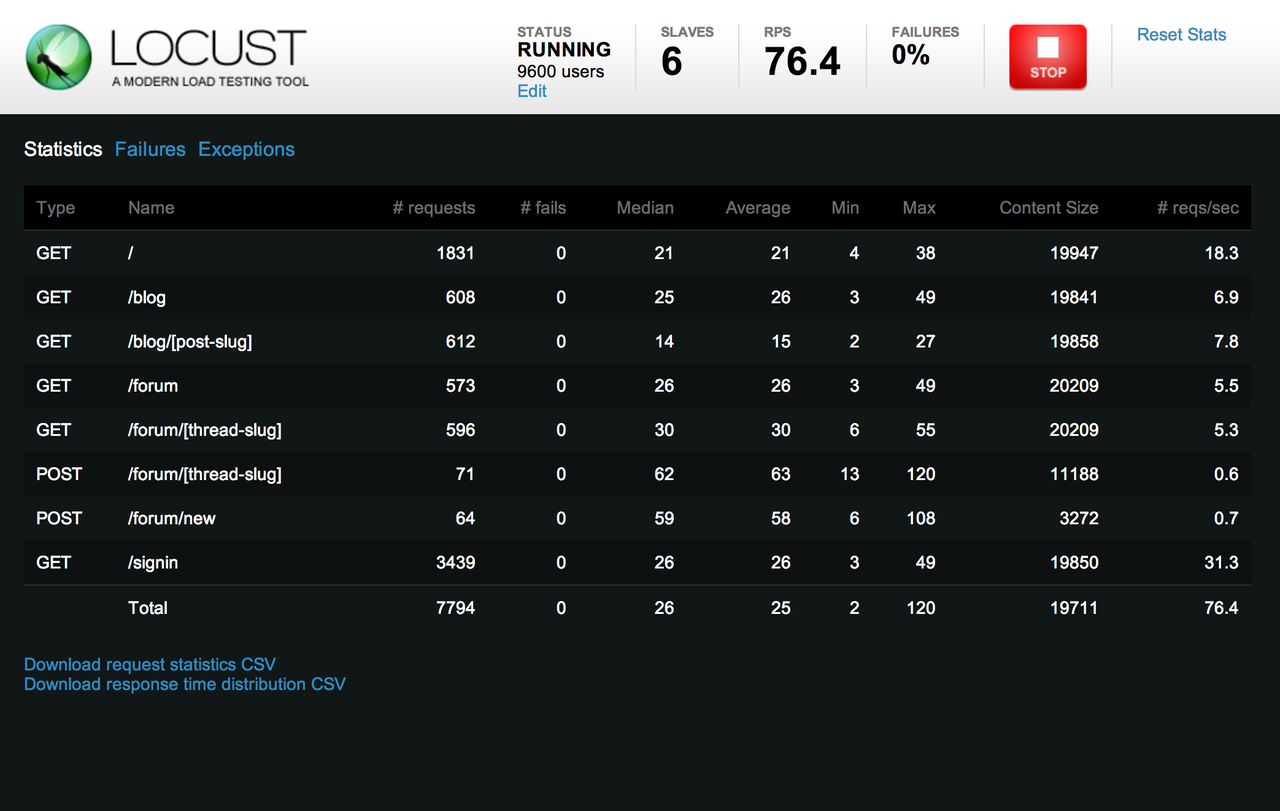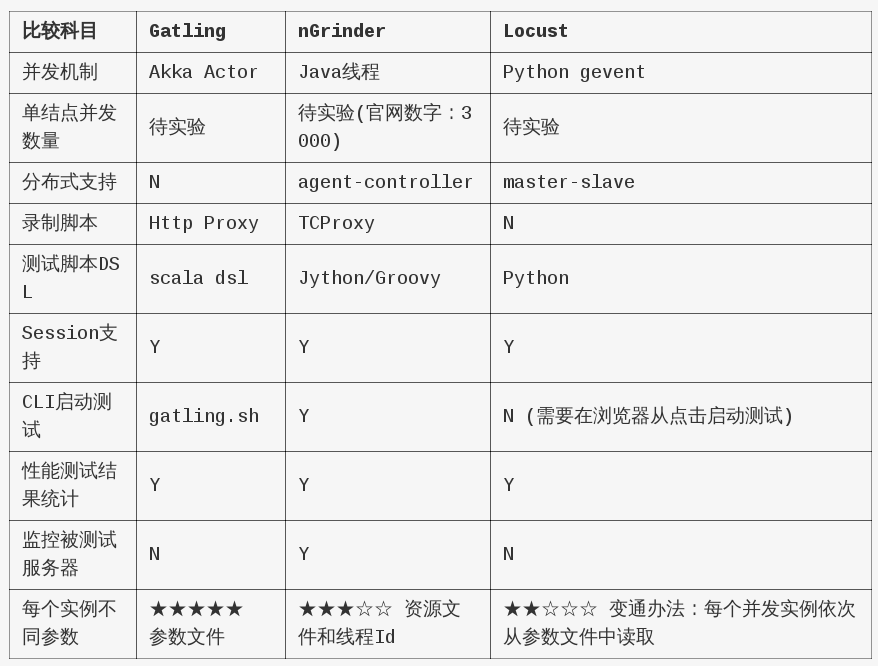
希望选择一款 Web Service 性能测试工具,能真实模拟大量用户访问网站时的请求,从而获取服务器当前的请求处理能力(请求数/秒)。
以微信服务器为例,每个用户用独立的登录 token,做各种操作,比如刷消息、发消息、看朋友圈等。
希望该性能测试工具符合如下要求:
Gatling 是一款基于 Scala 开发的高性能服务器性能测试工具,它主要用于对服务器进行负载等测试,并分析和测量服务器的各种性能指标。Gatling 主要用于测量基于 HTTP 的服务器,比如 Web 应用程序,RESTful 服务等,除此之外它拥有以下特点:
测试场景示例:
http://gatling.io/docs/2.1.7/advanced_tutorial.html
object Search {
val feeder = csv("search.csv").random // 1, 2
val search = exec(http("Home")
.get("/"))
.pause(1)
.feed(feeder) // 3
.exec(http("Search")
.get("/computers?f=${searchCriterion}") // 4
.check(css("a:contains('${searchComputerName}')", "href").saveAs("computerURL"))) // 5
.pause(1)
.exec(http("Select")
.get("${computerURL}")) // 6
.pause(1)
}
统计图:

官网很卡,真的很卡...zzz...
http://naver.github.io/ngrinder/
nGrinder 是一个基于 Grinder 开发的一个非常易于管理和使用的性能测试系统。
它是由一个 controller 和连接它的多个 agent 组成,用户可以通过 web 界面管理和控制测试,以及查看测试报告,controller 会把测试分发到一个或多个 agent 去执行。用户可以设置使用多个进程和线程来并发的执行该脚本,而且在同一线程中,来重复不断的执行测试脚本,来模拟很多并发用户。
nGrinder 的测试是基于一个 python 的测试脚本,用户按照一定规则编写测试脚本以后,controller 会将脚本以及需要的其他文件分发到 agent,用 Jython 执行。并在执行过程中收集运行情况、响应时间、测试目标服务器的运行情况等。并保存这些数据生成运行报告,以供以后查看。
nGrinder 的一大特点就是非常容易使用,安装也非常容易,可以做到开箱即用,测试用户也可以很容易就开始测试任务。当然,如果想执行一些比较复杂场景的性能测试,就需要测试人员对 python 有一定认识。
测试场景示例:
http://grinder.sourceforge.net/faq.html#simulating-users
#
# testRandomise.py
#
import random
import string
class TestRandomise:
def __init__(self, filename):
self._users = []
infile = open(filename, "r")
for line in infile.readlines():
self._users.append(string.split((line),','))
infile.close()
def getUserInfo(self):
"Pick a random (user, password) from the list."
return random.choice(self._users)
#
# Test script. Originally recorded by the TCPProxy.
#
from testRandomise import TestRandomise
tre = TestRandomise("users.txt")
class TestRunner:
def __call__(self):
# Get user for this run.
(user, passwd) = tre.getUserInfo()
# ...
# Use the user details to log in.
tests[2002].POST('https://host:443/securityservlet',
( NVPair('functionname', 'Login'),
NVPair('pagename', 'Login'),
NVPair('ms_emailAddress', user),
NVPair('ms_password', passwd), ))
统计图:

Locust 是一个开源负载测试工具。使用 Python 代码定义用户行为,也可以仿真百万个用户。
Locust 是非常简单易用,分布式,用户负载测试工具。Locust 主要为网站或者其他系统进行负载测试,能测试出一个系统可以并发处理多少用户。
Locust 是完全基于时间的,因此单个机器支持几千个并发用户。相比其他许多事件驱动的应用,Locust 不使用回调,而是使用轻量级的处理方式 gevent。
测试场景示例:
http://docs.locust.io/en/latest/quickstart.html#example-locustfile-py
from locust import HttpLocust, TaskSet
def login(l):
l.client.post("/login", {"username":"ellen_key", "password":"education"})
def index(l):
l.client.get("/")
def profile(l):
l.client.get("/profile")
class UserBehavior(TaskSet):
tasks = {index:2, profile:1}
def on_start(self):
login(self)
class WebsiteUser(HttpLocust):
task_set = UserBehavior
min_wait=5000
max_wait=9000
统计图:

因为没有脚本能力或 CLI,所以未加入比较
Locust 作者对 JMeter 和 Tsung 发的牢骚:
http://my.oschina.net/u/1433482/blog/464092#OSC_h4_3
我们研究了现有的解决方案,都不符合要求。比如 Apache JMeter 和 Tsung。
JMeter 基于 UI 操作,容易上手,但基本上不具备编程能力。其次 JMeter 基于线程,要模拟数千用户几乎不可能。
Tsung 基于 Erlang,能模拟上千用户并易于扩展,但它基于 XML 的 DSL,描述场景能力弱,且需要大量的数据处理才知道测试结果。

很明显,首选的全能选手就是 Gatling ,Akka Actor 的并发模型就是来自于并发语言的鼻祖 Erlang。
如果想自己扩展性能测试工具,那么 Locust 这个小而精的工具可以考虑。
nGrinder 工具是韩国版微信 Line 开源的,并且专门开设了中文论坛,由韩国工程师回答中国开发者。但有两个问题,一是官网太卡,其二示例都是片段不完整。
各位同学参照上面的对比,自己各取所需吧。
